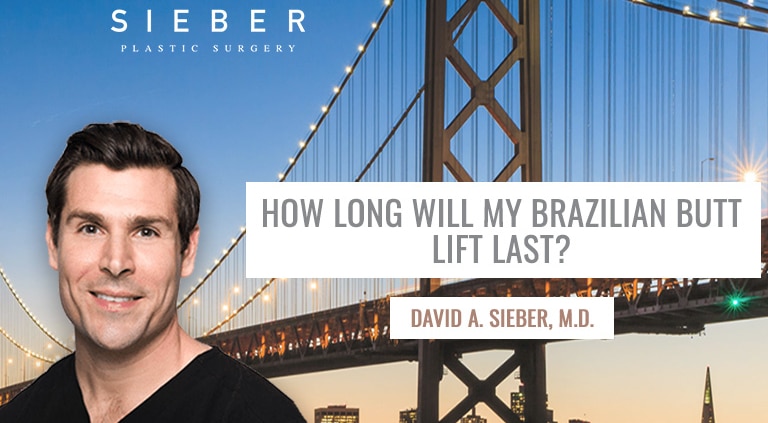How Long Will My Brazilian Butt Lift Last?
During a BBL consultation appointment, it is common for patients to inquire about the duration of a full Brazilian Butt Lift procedure. This is a valid concern as individuals undergoing such a significant surgery naturally desire long-lasting results. In the following sections, we will aim to provide a comprehensive answer to this question.
However, before delving into the details, let’s take a brief overview of what a Brazilian Butt Lift procedure entails.
 WHAT IS A BBL?
WHAT IS A BBL?
A Brazilian butt lift — or BBL, for short — is a fat transfer procedure that involves removing excess fat from one or several areas of the body and re-injecting that fat into the buttock, thighs and hips. The first stage of the procedure is performed using liposuction.
Brazilian butt lift surgery has been increasing in popularity in recent years because of the general desire people have for larger bottoms and smaller, “snatched” waists. This is an especially desirable figure for women who naturally have “straight” or “apple-shaped” figures and who want more curves.
HOW LONG DOES A BBL LAST?
In brief, there’s no simple answer to the question, “How long does a BBL last?”.
Some plastic surgeons like to throw around the time period of five or six weeks to 10 years, and certainly, this is possible for many patients. We have seen a fat transfer BBL after 10 years do very well.
Still, it’s difficult to give a specific answer to the aforementioned question because there are so many variables involved. Below, we’ll go over a few of the most impactful variables and factors when it comes to determining the permanency of your Brazilian butt lift procedure based of the BBL technique used. Use this information to your advantage, to help maintain your BBL results for as long as possible.
FACTORS INFLUENCING THE LONGEVITY OF BBL RESULTS
1. HOW WELL THE FAT ADHERES DURING AND DIRECTLY AFTER SURGERY
First, we need to take a look at how well the fat “sticks” to its new location in the buttock area.
When your surgeon uses liposuction to remove the unwanted fat from your abdomen or butt implants (or another place where you have pockets of undesirable fat), that fat needs to “survive” the transfer. In other words, it needs to become living fat in its new location, and it will do this when each fat cell achieves a new blood supply in the buttock.
Unfortunately, not all fat is going to survive this healing process. There is going to be a certain percentage of “fat loss” in every surgery, and the more fat that doesn’t make it, the fewer the number of cells that will remain to maintain your results.
2. THE MIGRATION OF FAT DIRECTLY AFTER SURGERY
Another factor that will impact how long your Brazilian Butt Lift will last is whether or not the “new fat” ends up migrating during your recovery period.
During the weeks and months directly after your surgery, it is important that you follow all of the aftercare instructions given to you by your surgeon. For example, you will be told to avoid sitting directly on your buttocks. You will be told not to lie down on your back so that you can keep the weight and pressure off of your buttocks.
When patients don’t follow these directions closely is when problems arise and long-term results are affected.
For example, if you were to sit directly on your buttocks or lean on one side of your buttocks for even an hour or so, this could actually cause the excess fat that were injected into your hips and buttocks to migrate to another area. That’s because the injected fat is still malleable and unstable at this point.
Think of it this way: Directly after BBL surgery, the fat in your buttocks and hips is acting a bit like toothpaste in a tube. That is, if you were to press on one end of a tube of toothpaste, the toothpaste would expand to the opposite end of the tube and cause that side of the tube to expand. There would also be a depression left where you pushed down.
You need to avoid putting any type of pressure on your buttocks for at least several weeks after surgery, or this could compromise your results.
3. HOW WELL THE PATIENT MAINTAINS THEIR BODY WEIGHT AFTER SURGERY
One of the most important and impactful things you can do after Brazilian butt lift surgery in order to maintain your results is to maintain a healthy lifestyle and your body weight. Here’s why:
Every person is born with a certain amount of excess fat. If you have liposuction performed, a certain number of remove excess fat cells are permanently removed from your body (and they won’t grow back). But some fat cells will always remain — even where liposuction is performed.
On your buttocks and hip areas, you will naturally be receiving additional cells during your Brazilian Butt lift surgery. These cells are ultimately going to act like any other cells you’ve ever had in the fat tissue in your body. If you gain weight (i.e., if you consume more calories than your body needs), each of the fat cells is going to expand. And your buttocks will expand in size. Even areas where you had liposuction will expand in size.
On the other hand, if you consume fewer calories than your body needs and create a calorie deficit, the fat cells in your buttocks will shrink in size, and you will actually lose results because your overall butt size will shrink.
The sweet spot in terms of body weight after your Brazilian butt lift is simply to maintain the same body weight you had when you had surgery. This is best done through consuming a healthy diet of clean, whole foods and exercising regularly — performing both cardiovascular workouts and strength training exercises.
 Questions and Answers
Questions and Answers
How permanent is a BBL?
The outcomes of your Brazilian butt lift procedure are considered semi-permanent. This is because fat cells in the body naturally undergo changes over time, making it unrealistic to expect a completely permanent outcome from the surgery.
Will I lose my BBL if I workout?
Engaging in exercise and experiencing weight loss after undergoing a Brazilian Butt Lift (BBL) will not accelerate the reduction of grafted fat any more than the fat on other areas of the body.
However, it is important to note that the individual fat cells, often referred to as “balloons,” may shrink in size.
Will you still have your fat transfer BBL after 10 years?
By diligently following the necessary measures to preserve your Brazilian Butt Lift procedure results, you can anticipate retaining a substantial portion of the fat transferred to your buttocks for numerous years.
Remarkably, certain individuals have successfully maintained their Brazilian Butt Lift (BBL) outcomes even after a decade. It is entirely plausible for the results of a BBL to endure for several decades, eliminating the necessity for a secondary BBL procedure.
SCHEDULE YOUR BBL CONSULTATION TODAY
Want to find out more about Brazilian butt lift surgery and how long your personal results would be expected to last?
A consultation appointment is your chance to speak one-on-one with Dr. Sieber about your options, candidacy, and long-term outlook. Schedule your consultation by contacting our office today.
REFERENCES
https://www.medicinenet.com/how_long_does_a_brazilian_butt_lift_last/article.htm




 WHAT IS A BBL?
WHAT IS A BBL? Questions and Answers
Questions and Answers